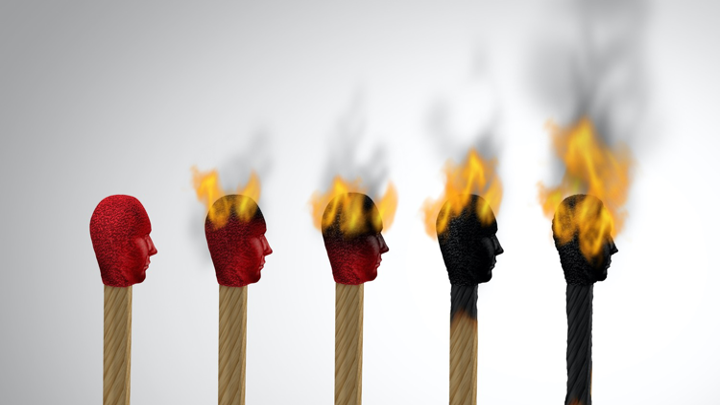Why Are People Quitting Their Jobs? Burnout & The Great Resignation

Post 1 in a 3-Post Series
“The Great Resignation” has been making headlines for months, impacting organizations in every sector. This is not a passing phenomenon but rather a distinct shift in the relationship between employees and the organizations they work for. In this 3-post series, I compile a wide range of studies to give you a more comprehensive picture of why this is happening and what it means for 2022 and the future of work.
What we are seeing is more complex and potentially serious than you may think. The Great Resignation is a wake-up call for today’s business leaders, and if they don’t heed the warning and quickly, this could morph into The Great Revolt. It already is.
Striking for Change
October has seen the launch of worker strikes across a range of industries from manufacturing to healthcare to media. The current labor shortage has tipped the balance of power to employees, and they know it. But they are not making pie-in-the-sky demands. Workers who are striking are asking for these basic elements of safety.
- A living wage that allows them to afford housing and food. Did you know that a full-time worker who earns minimum wage can afford a one-bedroom rental in only 7% of all counties in the U.S.?
- A working environment that is physically safe, where they won’t be exposed to a deadly virus, be assaulted by abusive customers, or get injured because they’re exhausted from long shifts. Every 7 seconds, a U.S. worker is injured on the job—that’s over 12,000 per day and 4.5 million per year. In 2019, 4,572 Americans died due to preventable workplace injuries.
- The conditions and resources to do their jobs. For example, teachers are asking for higher student/teacher ratios, and nurses are asking for higher nurse/patient ratios. In many workplaces, budgets have been cut to the point where employees spend their own money or are doing the workloads of several colleagues long since gone.
According to the Washington Post, “Economists say that low-wage workers are revolting against years of poor pay and stressful conditions.”
Many strikers are essential workers who feel betrayed after making sacrifices during the pandemic, where they worked long hours in dangerous conditions to keep the economy and their organizations afloat. But now, they are watching the executives and shareholders reap the benefits. The recent strike at a large manufacturing company is one example. After one of the best earnings years for the company, workers received a 5% raise while the CEO received 160%, his salary rising to $15.6 million per year.
The growing inequality between executives and workers is a critical issue. Tom Kochran, a work and employment researcher at MIT, says that the growing number of billionaires in the U.S. (now 724) have a total net worth that is more than the bottom 50% of all Americans. According to Forbes, “Despite the pandemic, it was a record-setting year for the world’s wealthiest—with a $5 trillion surge in wealth and an unprecedented number of new billionaires.”
As of December 2021, the top 6 billionaires are Elon Musk ($251B), Jeff Bezos ($195B), Bernard Arnault ($163B), Bill Gates ($135B), Larry Page ($128B), and Mark Zuckerberg ($124B). Many of them face ongoing criticism from their own employees about unsafe conditions, unethical behavior, and shortchanged pay.
Quitting in Record Numbers
Workers who cannot strike are resigning in record numbers. Coined “The Great Resignation” by organizational psychologist Anthony Klotz, quitting has hit the highest level in two decades. October was the 7th straight month of record resignations, with 4.2 million people quitting. That’s nearly 3% of the workforce in October alone, and collectively almost 28 million have quit since April. Studies show that 40-95% of workers are currently considering changing jobs, the biggest group being mid-level employees, ages 30 to 45.
Who is leaving? A Harvard study found that “Resignation rates were higher among employees who worked in fields that had experienced extreme increases in demand due to the pandemic, likely leading to increased workloads and burnout.”
The quit rate in the hotel/restaurant industry was 6.8%, over double the average rate across all sectors. That’s 892,000 workers leaving, impacting small and large businesses in every community. Today, these workers are more likely to take the brunt of abusive behavior as they deal with angry guests who argue with mask and vaccine mandates.
It comes as no surprise that healthcare workers are also leaving in droves. They are physically and emotionally exhausted after fighting to save lives for months. They care deeply about their patients, and the high death tolls have become unbearable.
Even white-collar workers who could work from home are resigning. According to Business Insider, “Those in tech and healthcare jobs, specifically, are quitting at the highest rates. And it's not just because of pay, but because they don't feel valued at work.”
Tech workers bore the burden of enabling work to continue through the lockdowns by pivoting their entire workforce to online tools for communication and collaboration. Futurist Amy Webb says, “2020 saw a decade of digital transformation in the span of a few months.” Tech workers, in particular, lost many of the benefits their offices provided, like onsite meals, gyms, and childcare.
Women have also resigned in record numbers, many during the early stages of the pandemic to handle childcare and school closures. While this population is now seeing a break with schools opening, they are exhausted and continue to outpace men in quitting rates each month.
The Great Resignation is affecting board rooms too. A study of nearly 1100 companies across 24 countries found 103 newly appointed new chief executives in the first half of 2021, more than double the previous six months.
Burnout is Taking a Heavy Toll
Burnout is the number one reason employees cite for leaving their current jobs. Burnout is a diagnosable state of emotional, physical, and mental exhaustion brought on by long-term stress.
Leadership coach Dr. Kim Hires posted a video saying, “People are not alright. And it’s been a long time coming, but I think everything with Covid and the last 18 months has just sent everyone over the edge; entire industries are about to implode.” More telling are the comments left by the thousands of viewers, including:
“I am not alright, and I don’t know if I can be the same employee I used to be. I’m a different person now. I just don’t GAF about anything.”
“I cry daily at work. I’m not even saving lives. I just work in Corporate America.”
“I have no motivation to work anymore. I don’t even care if I get fired… #overit.”
“We were just discussing this in my HR Management class. It was coming but COVID escalated it. People won’t settle anymore! ”
During natural disasters, Dr. Ann Masten says that humans can tap into what scientists call our “surge capacity,” mental and physical systems designed to help us survive acutely stressful situations, like a hurricane or earthquake. But we deplete that capacity after about six months when most communities see signs of recovery. Not so for this pandemic.
In their book Burnout: The Secret to Unlocking the Stress Cycle, Drs. Emily and Amelia Nagoski identify three main components of burnout: emotional exhaustion, lack of accomplishment, and depletion of empathy.
Lack of accomplishment and depletion of empathy are particularly responsible for the rise in resignations. No matter how hard people work, they just feel like they are spinning their wheels. And as their negative feelings grow, some inevitably project them onto their job.
The truth is that the only cure for burnout is to rest, not start another job. This is why hiring managers are seeing an increase in ghosting behavior, both by applicants and 25% of new hires who fail to show up for their first day. Employees who do show up are still in danger of quitting within a short period.
We are also seeing boomeranging—employees who quit their jobs due to burnout but did not yet start another job have now had enough time to rest. Many of them are returning to their organizations.
Burnout was a serious problem even before the pandemic, costing nearly $200 billion in related healthcare costs in the United States alone. In 2019, the World Health Organization declared burnout an occupational disease due to workplace stress not being successfully managed. At that time, about 53% of the workforce was burned out. But now, it has hit extraordinary levels. In the spring, up to 70% of people were experiencing burnout; new studies show that it’s risen to 89%.
Burnout creeps up slowly, making us too tired to care or take positive action. Psychologist Christine Hohlbaum states, “Sadly, most people don’t even notice its gradual grip over their lives until it’s too late. By then, external intervention is necessary to move burnout patients toward positive change.” Burnout, for this reason, is also called “the erosion of the soul.”
Burnout is called the erosion of the soul.
Psychologist Dr. Sherrie Bourg Carter states, “When you are in the throes of full-fledged burnout, you are no longer able to function effectively on a personal or professional level.” It is likely that burnout is contributing to the recent rise in conflict and incivility occuring in workplaces around the world. Employee surveys now feature comments like:
“I’m seeing a lack of professionalism and passive aggressiveness up to overt aggression.”
“I was on a conference call that was the most unprofessional interaction I’ve ever had.”
“I’ve seen more of my people cry in the last 4 months than I have in my entire career.”
People literally don’t have the ability to control their emotions, nor can they feel empathy or compassion for any damage their outbursts might do to others. This ultimately takes a toll and can lead to more resignations. Doctors Porath and Pearson studied how the bad behavior of one employee negatively impacted their coworkers. They found:
- 80% lost work time worrying about the incident
- 78% said their commitment to the organization declined
- 66% felt their performance declined
- 48% intentionally decreased their work effort and time at work
- 12% left the job
Addressing burnout needs to be our first priority. We need to teach people what it is and how to recognize the signs in themselves and others. We need to have open conversations about it and the toll it is taking. Most importantly, we need to encourage people to rest and recharge. That is really the only cure for burnout and many people are beyond being able to help themselves.
As we approach the holidays, it can be a great time to give people a few more days off (or take them ourselves). Where possible, simplify or scale back on plans to create more room for resting and recharging. To create a better boundary with work, disconnect the email push to your phone so that you’re not tempted to work when you’re bored. Focus on doing things that are fun or playful even if they may not seem initially appealing—burnout has stripped away our ability to feel joy so we have to lean into reclaiming our happiness.
This is the end of Post 1. In Post 2, we will look at the perfect storm of critical factors that created The Great Resignation. In Post 3, 7 Strategies Leaders Can Implement Now to Win The Great Resignation we will look at strategies leaders can use now to overcome The Great Resignation.
Related Blogs
JOIN OUR COMMUNITY
Be the first to know of Dr. Britt Andreatta's latest news and research.





